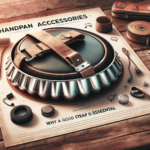Introduction
The world of music is as varied as it is rich, offering an endless array of instruments and sounds that captivate the listener’s soul. One of the more recent additions to this vibrant landscape is the handpan, an instrument renowned for its ethereal and melodic tones. But within the handpan community, a lesser-known aspect is the creation of custom handpan scales, a practice that allows musicians to craft their unique soundscapes. This article explores the art of custom handpan scales, delving into the processes, techniques, and creativity involved, and culminating in a deeper understanding of how these instruments produce their mesmerising sounds.
The Allure of Handpans
The handpan is a percussion instrument with a distinctive UFO shape, constructed from metal and possessing a set of tuned notes. Its enchanting tones and harmonics make it perfect for contemplative music and improvisational play. Invented in the early 2000s, handpans quickly gained popularity for their ability to produce a wide range of emotive sounds. Traditionally, handpans are built with predefined scales, determined by the number of notes they contain and their arrangement on the instrument. However, a growing number of musicians seek to expand the expressive possibilities of their handpans through custom scales.
Understanding Handpan Scales
In the realm of handpans, a scale is essentially a set of musical notes that are organized in a specific order to produce a distinct sonic experience. Standard handpan scales are typically derived from well-known musical scales such as major, minor, and pentatonic. These traditional scales provide beautiful melodies and harmonious chords, yet they may not entirely satisfy the creative desires of musicians seeking a more personal or unique sound.
The Art of Creating Custom Scales
Creating a custom handpan scale is both an art and a science. It involves a deep understanding of music theory, the physics of sound, and the skills to manipulate metal into precisely tuned notes. To craft these unique scales, a handpan maker or musician will often begin with a series of considerations, including:
- Purpose and Intention: Understanding what the musician hopes to achieve with the custom scale is crucial. This could range from evoking a specific mood to embodying a cultural theme or simply exploring new sonic possibilities.
- Musical Elements: Decisions on the number of notes, note intervals, and harmonics form the foundation of the custom scale. Each element contributes to the overall sound, whether it is warm, bright, melancholic, or joyous.
- Technical Skills: Crafting a custom scale requires precision in hammering and tuning the handpan’s steel surface. A skilled artisan must balance intuition and technique to ensure each note is perfectly resonant.
- Collaboration: Musicians often work closely with handpan makers to articulate their vision and tweak the scale through iterative feedback.
Innovative Techniques
As with any form of art, innovation plays a significant role in the creation of custom handpan scales. Handpan makers continuously experiment with new techniques and materials to push the boundaries of what is possible. Some of these innovative approaches include:
- Material Variation: Different metals such as stainless steel, nitrided steel, and even exotic alloys can influence the tonal qualities of the handpan, offering a unique touch to custom scales.
- Damping Techniques: Adjusting the instrument’s sustain and resonance through damping techniques allows for a wide range of sonic textures and timbres.
- Complex Harmonics: By carefully adjusting the overtone structure, makers can create scales that highlight specific harmonics, giving rise to new auditory experiences.
- Alternative Tunings: Deviating from the standard 440 Hz tuning convention and exploring microtonal or just intonation scales opens up new pathways for musical exploration.
The Musical Impact of Custom Handpan Scales
The impact of custom scales on a musician’s repertoire is profound. These scales can transform a handpan session into a deeply personal journey, where each note holds significance and emotion. Musicians can transcend traditional musical boundaries, crafting compositions that resonate with their personal experiences and cultural influences. Furthermore, custom scales offer therapeutic benefits, as players can intuitively express their feelings and meditative states through unprecedented sonic landscapes.
Challenges in Creating Custom Scales
Despite the allure of crafting custom scales, it is not without challenges. The process demands a meticulous attention to detail, a deep comprehension of acoustics, and the patience to refine the scale through numerous iterations. Additionally, the rarity of skilled handpan makers who can craft custom scales makes them a unique commodity in the musical world. There is also a financial aspect to consider, as custom handpans are often more costly due to the labor-intensive processes and expertise involved.
A Community of Creators
The handpan community plays a pivotal role in the evolution of custom scales. Through forums, workshops, and festivals, musicians and makers share insights, ideas, and innovations. This collective exchange encourages experimentation and increases the availability of diverse scales to a wider audience. As the community grows, so does the potential for exploring new frontiers in sound and music.
Conclusion
Custom handpan scales offer musicians a unique canvas to express their individuality and creativity. The art of creating these scales involves a blend of musical intuition, technical prowess, and innovative spirit. As musicians continue to explore the depths of their creativity through custom scales, the handpan stands as a testament to the ever-expanding boundaries of musical exploration. Whether driving personal enrichment or pushing the frontiers of contemporary music, custom handpan scales hold the power to transform the musical experience, offering fresh perspectives and timeless sounds.
FAQs
1. What is a handpan?
A handpan is a magical percussion instrument made from metal, resembling a UFO, known for its soothing and melodic tones. It’s played with the hands, and its shape and design allow for a range of notes that produce harmonic soundscapes.
2. How are handpan scales arranged?
Handpan scales are sequences of notes arranged in a specific order on the instrument’s surface. Traditional scales may include major, minor, or pentatonic sequences, while custom scales are uniquely crafted based on the musician’s intent and preferences.
3. Why create custom handpan scales?
Custom handpan scales offer musicians the opportunity to define their unique sounds, explore new artistic expressions, and tailor their music to evoke specific emotions or cultural themes. These scales are a pathway to personalizing one’s musical journey.
4. What skills are required to create custom handpan scales?
Creating custom scales requires an understanding of music theory, expertise in metalworking for tuning, and an ear for music to ensure the instrument’s notes are harmonious. It involves both technical precision and artistic creativity.
5. Are custom handpans more expensive?
Yes, custom handpans often come with a higher price tag due to the specialized skills, labor, and time involved in crafting unique scales. They are a more personalized instrument, reflecting the maker’s craftsmanship and the musician’s vision.





